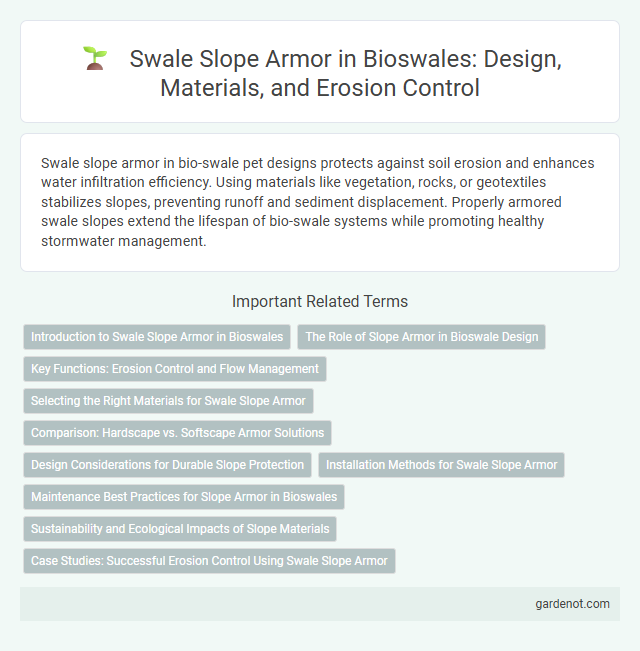Swale slope armor in bio-swale pet designs protects against soil erosion and enhances water infiltration efficiency. Using materials like vegetation, rocks, or geotextiles stabilizes slopes, preventing runoff and sediment displacement. Properly armored swale slopes extend the lifespan of bio-swale systems while promoting healthy stormwater management.
Introduction to Swale Slope Armor in Bioswales
Swale slope armor is an essential component in bioswales designed to prevent erosion and maintain soil stability along the slope. Typically composed of materials like riprap, vegetation mats, or engineered fabrics, slope armor absorbs and dissipates the energy of flowing water, protecting the bioswale's structure. Effective implementation of swale slope armor enhances both the durability and functionality of bioswales in stormwater management systems.
The Role of Slope Armor in Bioswale Design
Slope armor in bioswale design plays a crucial role in preventing soil erosion and maintaining structural integrity during heavy rainfall. Materials such as riprap, geotextiles, or vegetation mats stabilize the swale's incline, reducing surface runoff velocity and promoting infiltration. Effective slope armor enhances bioswale longevity by protecting against sediment displacement and supporting healthy vegetation growth.
Key Functions: Erosion Control and Flow Management
Swale slope armor primarily functions to prevent soil erosion by stabilizing the channel slopes with durable materials such as riprap, vegetation, or engineered mats. This protective layer manages flow velocity, reducing surface runoff energy and promoting infiltration to minimize sediment displacement. By controlling erosion and regulating water flow, swale slope armor enhances the bio-swale's effectiveness in stormwater management and environmental protection.
Selecting the Right Materials for Swale Slope Armor
Choosing the right materials for swale slope armor is critical to preventing erosion and enhancing water infiltration in bio-swales. Durable options like natural stone, biodegradable coir mats, and native vegetation effectively stabilize slopes while supporting ecological function. Incorporating permeable and compatible materials tailored to local soil and climate conditions ensures long-term slope integrity and sustainable stormwater management.
Comparison: Hardscape vs. Softscape Armor Solutions
Swale slope armor enhances erosion control and water infiltration in bio-swales by stabilizing soil on slopes. Hardscape armor, such as concrete or stone, offers durable protection against heavy runoff but may reduce permeability and increase surface runoff velocity. Softscape armor, using vegetation and biodegradable mats, promotes natural water absorption and habitat creation while requiring ongoing maintenance to sustain effectiveness.
Design Considerations for Durable Slope Protection
Swale slope armor must be designed to withstand heavy stormwater flows and prevent soil erosion while maintaining permeability for water infiltration. Selecting durable materials such as riprap, geotextiles, or vegetation mats ensures long-term stability and reduces maintenance needs. Properly grading the slope at an optimal angle of 3:1 or flatter minimizes runoff velocity and avoids undermining the armor's effectiveness.
Installation Methods for Swale Slope Armor
Swale slope armor installation methods involve securing erosion control materials such as geotextiles, riprap, or vegetation mats onto the slope surface to stabilize soil and manage stormwater runoff. Techniques include anchoring with stakes or pins, layering with biodegradable fabrics, and placing vegetation plugs to promote root establishment. Proper slope grading and compaction ensure effective armor placement, reducing sediment displacement and enhancing water infiltration in bio-swale systems.
Maintenance Best Practices for Slope Armor in Bioswales
Regular inspection of swale slope armor is essential to prevent erosion and maintain structural integrity in bioswales. Employing native vegetation and biodegradable geotextiles enhances slope stability while reducing sediment displacement. Prompt removal of debris and repair of damaged materials ensures optimal water infiltration and pollutant filtration performance in bioswale systems.
Sustainability and Ecological Impacts of Slope Materials
Swale slope armor plays a crucial role in enhancing sustainability by preventing soil erosion and promoting water infiltration, which supports natural groundwater recharge. Using eco-friendly materials such as native vegetation, biodegradable geotextiles, and recycled aggregates minimizes environmental disruption and fosters biodiversity within the swale ecosystem. These sustainable slope materials reduce runoff velocity and filter pollutants, contributing to improved water quality and ecological balance.
Case Studies: Successful Erosion Control Using Swale Slope Armor
Swale slope armor has demonstrated remarkable effectiveness in controlling erosion across various case studies, particularly in urban and agricultural settings. Implementations using riprap, geotextiles, and vegetation mats have significantly reduced soil displacement and improved water infiltration rates by up to 70%. These case studies confirm that swale slope armor not only stabilizes soil but also enhances the longevity and sustainability of bio-swale systems.
Swale slope armor Infographic

 gardenot.com
gardenot.com